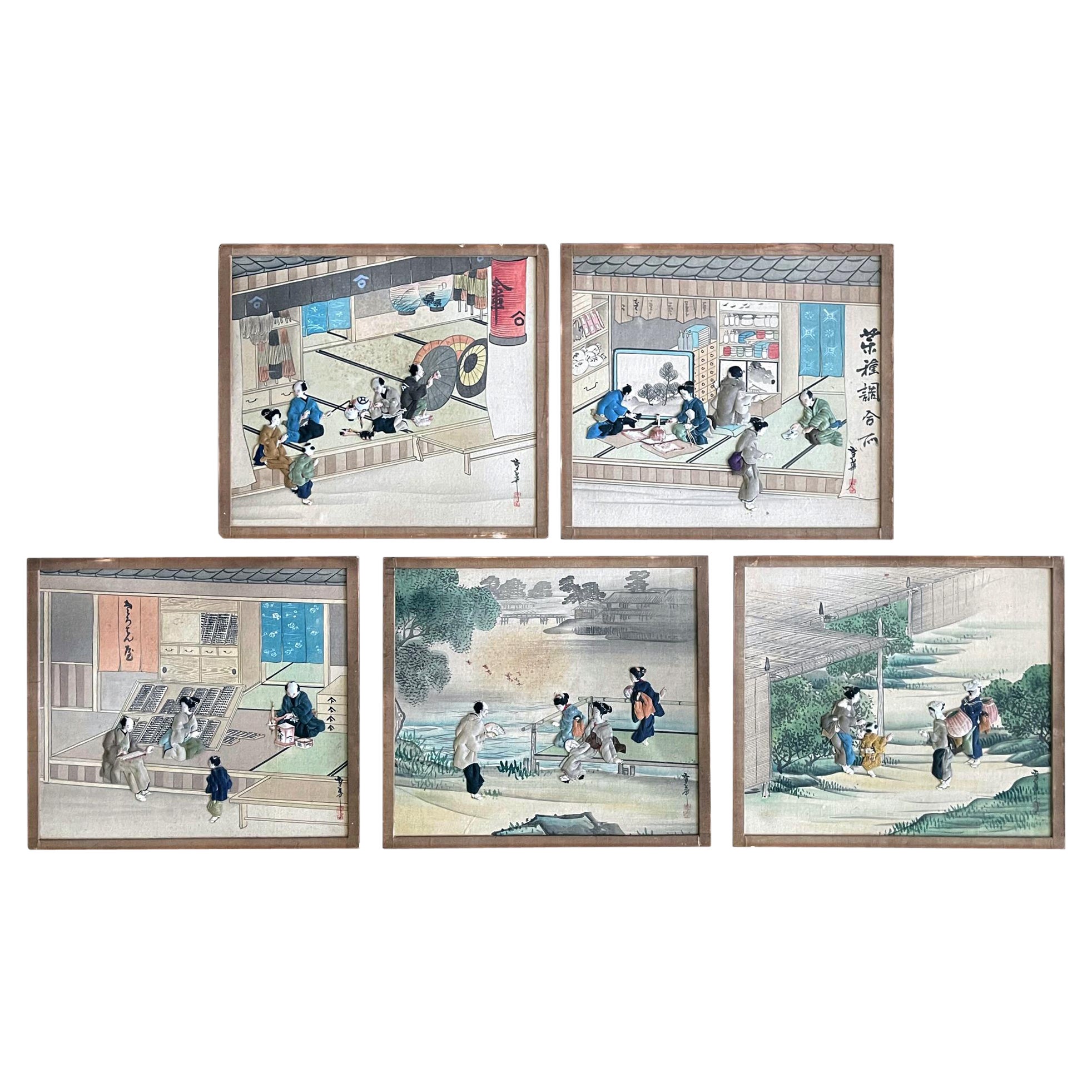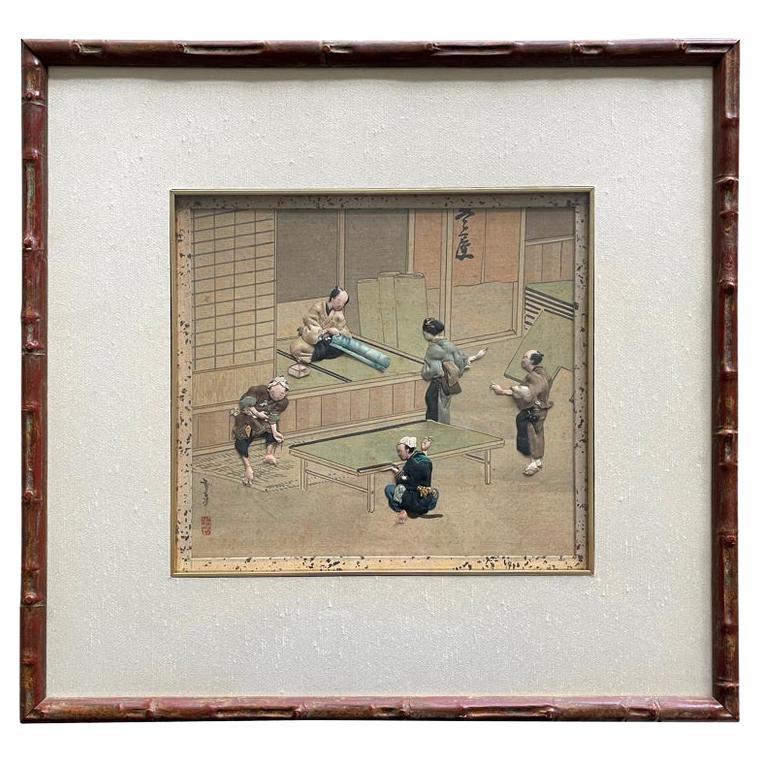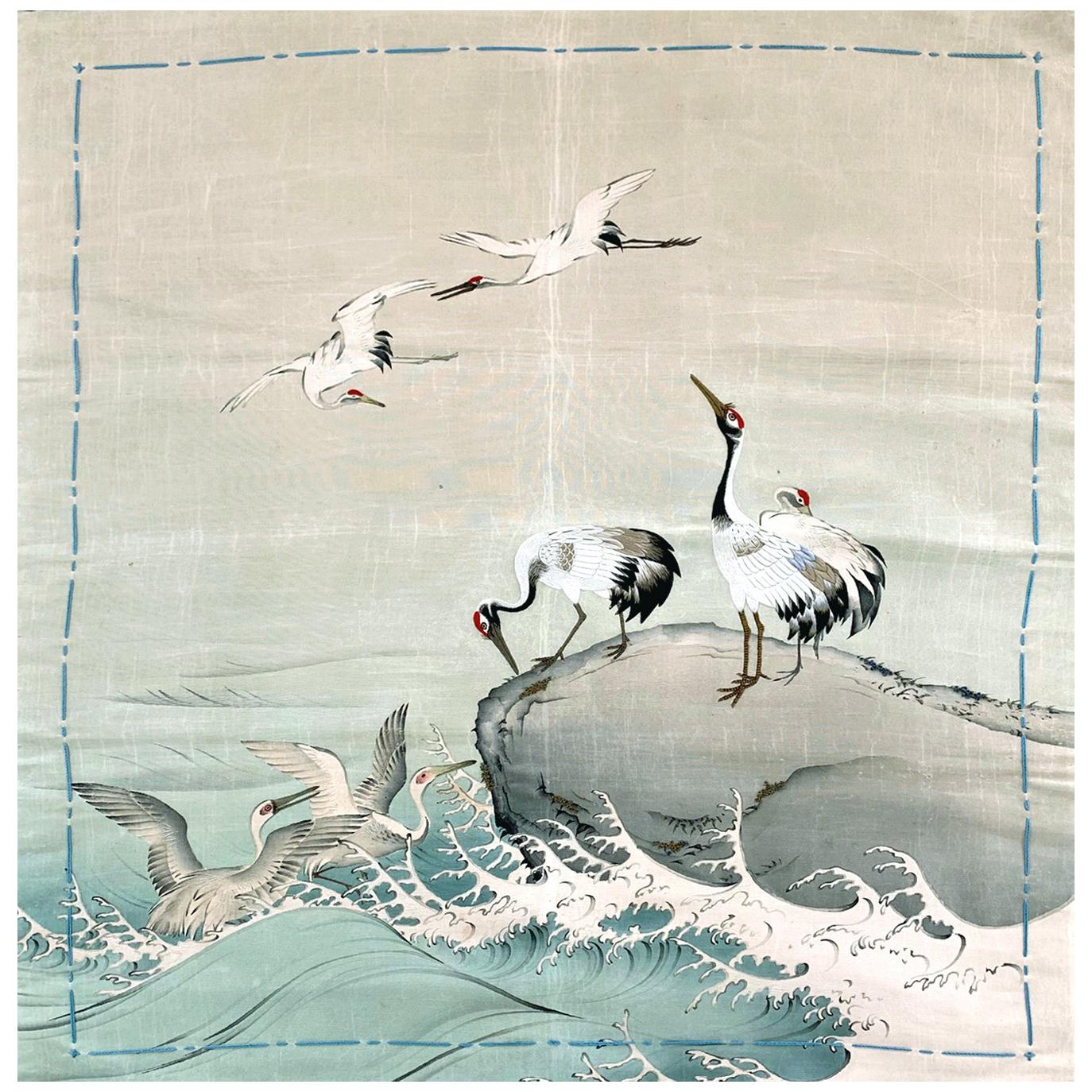Items Similar to Rare Historical Set Japanese Oshi-E Textile Art Panels Meiji Period
Want more images or videos?
Request additional images or videos from the seller
1 of 21
Rare Historical Set Japanese Oshi-E Textile Art Panels Meiji Period
About the Item
On offer here is a rare set of eleven Japanese textile art with painting panels called Oshi-E circa Meiji Period (1868-1912). This unusual set of panels depict various composition of oriental figures, animals and plants (even including a nanban foreigner), all in beautiful details. The panels were unframed and stored in a wood box inscribed with ink of the title and artist's name Eigetsu and seal. According to the note remained on the bottom of the box, they were gifted on the occasion of Christmas to a Miss M. L . Graves in 1891 by her Japanese students (with all their names listed) and remained in Putnam-Graves collection since. Each work is a wonderful example of the Oshi-E art form with its realistic rendering and attention to details. Each is signed and sealed by the artist, stamped Putnam-Graves collection and with penciled number verso. Preserved in near pristine condition, this love set was probably put away for decades and was never mounted. There is also a lovely ink painting under the lid with an inscription "I love ancient people", presumably by the artist as well.
The Oshi-E (also known as kiritori zaiku, literal translation as "Pressed Picture) is a type of ornamental textile art dated back to the Muromachi period (1392-1573). It started among the elite aristocratic women in Kyoto before spreading wider in the Japanese society. Throughout Edo and Meiji period, Oshi-E were sometimes used to make offerings to the altars in the temple and in the late 19th century, it was exported to the west along with the other embroidery textile art. Oshi-E was made by using silk wadding to create a relief design. Various silk fabric swaps and sometimes wires and tassels, often recycled from older kimonos among the other pieces, were used to create different desired effects. Much detail was focused on the elaborate dresses, head wears, faces, and plants in the setting. Ink and watercolors were used to facilitate the details of the design such as the background painting and the facial detailing. The work was time-consuming and in Meiji period, it was considered as a feminine accomplishment along with ikebana, embroidery and tea ceremony.
According to the book: Threads of silk and gold: ornamental textile from Meiji Japan published by Ashmolean Museum of art and archaeology University of Oxford, few examples survived to this day.
Reference: Threads of Silk and Gold: Ornamental Textile from Meiji Japan published by Ashmolean Museum of art and archaeology University of Oxford. Page 178.
- Dimensions:Height: 8 in (20.32 cm)Width: 7.25 in (18.42 cm)Depth: 0.1 in (2.54 mm)
- Sold As:Set of 11
- Style:Meiji (Of the Period)
- Materials and Techniques:
- Place of Origin:
- Period:
- Date of Manufacture:1891
- Condition:Wear consistent with age and use. Fine antique condition with little toning and occasional wear along the edges. Slightly arched with nature. The tomobako box shows lots of wear and cracks.
- Seller Location:Atlanta, GA
- Reference Number:1stDibs: LU945038970402
About the Seller
5.0
Platinum Seller
These expertly vetted sellers are 1stDibs' most experienced sellers and are rated highest by our customers.
Established in 2006
1stDibs seller since 2010
478 sales on 1stDibs
Typical response time: <1 hour
- ShippingRetrieving quote...Ships From: Atlanta, GA
- Return PolicyA return for this item may be initiated within 2 days of delivery.
More From This SellerView All
- Collection of Five Japanese Oshi-E Textile Art Panels Meiji PeriodLocated in Atlanta, GAOn offer is a set of five Japanese textile art panels called Oshi-E circa Meiji Period (1868-1912). This usual set of panels depict various aspects of daily life in Edo time with beautiful details. Some of these panels are snapshots of the buzzling commercial activities at the marketplace, providing insight into the signages, architecture, costumes and how people interacted within a historical and pictorial context. Other panels depict daily leisure activities such as lounging in the park or visiting friends. The realistic rendering and attention to details are not short of "photographic" quality. From the signage of the shops to the motions and attires of the individual characters, from the hairstyle, small ornaments, down to the facial expression, were all recorded in great details. Each panel was signed with the artist's name Yukihana in Kanji with a red seal. These panels are unframed and await your custom touch (framing with inner gilt spacer and mat costs about 250-500 depending on the material chosen, see a framed example in the last picture of a single framed panel we have for sale). We offer them for sale individually, but it will be great for a collector to consider the whole set so that they can stay together. The Oshi-E (also known as kiritori zaiku) is a type of ornamental textile art dated back to the Muromachi period (1392-1573). It started among the elite aristocratic women in Kyoto before spreading wider in the Japanese society. Throughout Edo and Meiji period, Oshi-E were sometimes used to make offerings to the altars in the temple and in the late 19th century, it was exported to the west along with the other embroidery textile art. Oshi-E was made by using silk wadding to create a relief design. Various silk fabric swaps and sometimes wires and tassels, often recycled from older kimonos...Category
Antique 1890s Japanese Japonisme Textiles
MaterialsSilk, Giltwood
- Framed Japanese Oshi-E Textile Art Meiji Period from a Rare Large SetLocated in Atlanta, GAOn offer is the last one of the set of seven framed Japanese textile art called Oshi-E circa Meiji Period (1868-1912). This rare set consists ...Category
Antique 1890s Japanese Japonisme Textiles
MaterialsSilk, Giltwood
- Japanese Antique Fukusa Textile Art Meiji PeriodLocated in Atlanta, GAA Japanese silk Fukusa panel circa late 19th-early 20th century of Meiji Period. The front was beautifully decorated with Yuzen-zome, a labor intensive resist-dye technique invested ...Category
Early 20th Century Japanese Japonisme Textiles
MaterialsSilk, Beads
- Japanese Antique Fusuka Textile Art Meiji PeriodLocated in Atlanta, GAA Japanese silk Fukusa panel circa late 19th-early 20th century of Meiji Period. The front was beautifully decorated with Yuzen-zome, a labor intensive resist-dye technique invested by an artist monk Miyazaki Yuzensai (1654 -1736) of Edo period. The auspicious composition features a group of red-crown cranes, the symbol of longevity. Three of them perch on the rock by the ocean (East Sea) an two of them are in flight. Additionally, two egrets frolic in the wave. Yuzen dying was used extensively to showcase the amazing details such as the waves and the gradual coloring effect. Embroidery was used sparsely to highlight areas such as the legs of the crane to render it more dimensional details. The piece has a red silk backing and still retains four blue tassels on corners as well as decorative stitches along the edges. Fukusa is a traditional Japanese textile...Category
Early 20th Century Japanese Japonisme Textiles
MaterialsBrocade, Silk
- Japanese Antique Fukusa Textile Art Meiji PeriodLocated in Atlanta, GAA Japanese silk Fukusa panel circa late 19th-early 20th century of Meiji Period. The front was beautifully decorated with Yuzen-zome, a labor intensive resist-dye technique invested by an artist monk Miyazaki Yuzensai (1654 -1736) of Edo period. The front cover likely depicts a scene from the Tale of Genji, showing a nobleman and his servant pays a visit to a lady in a fenced thatch-roof house under a high peak. The details of blossom trees and pines, as well as the characters, and scenery with a gradual color are astounding. It is telling that the Yuzen dying was used such an mastery. The piece has a red silk backing and still retains two red tassels on the lower corners as well as decorative stitches along the edges. There is a patched design on the back likely a Mon symbol (family crest). Fukusa is a traditional Japanese textile...Category
Early 20th Century Japanese Japonisme Textiles
MaterialsSilk
- Framed Japanese Embroidery Textile Panel Meiji PeriodLocated in Atlanta, GAA Japanese textile panel with embroidered picture work circa late Meiji period (1900s) presented in a gilt wood frame with silk mat. The work de...Category
Antique Early 1900s Japanese Meiji Textiles
MaterialsSilk, Wood
You May Also Like
- Meiji Period Japanese Indigo Double Ikat Futon CoverLocated in Point Richmond, CAMeiji period Japanese Indigo double ikat futon cover Japanese futon cover, a double ikat pattern in four panels depicting Kumamoto Castle with im...Category
Antique 1890s Japanese Meiji Textiles
MaterialsCotton
- Pair of 19th Century Chinese Textile Qing Dynasty Embroidered Sleeve PanelsLocated in London, GBA Pair Of Chinese Embroidered Sleeve Panels. China, 19th Century, Qing Dynasty. Antique textile ff rectangular form, with a central seam, one decora...Category
Antique 19th Century Chinese Qing Textiles
MaterialsSilk
- Late Meiji Period Sleeping Kimono / Yogi, JapanLocated in Point Richmond, CALate Meiji Period sleeping Kimono / Yogi, Japan Yogi are a type of oversized sleeping kimono traditionally used in Japan. This kimono would have b...Category
Early 20th Century Japanese Tribal Textiles
MaterialsCotton
- Antique Burnt Orange and Purple Silk TextileLocated in New York, NYStunning contrasting colors featuring a metallic fringe on this beautiful fine silk, tie dye ceremonial shoulder cloth from Palembang, Sumatra. Early 20 century. There are 2 very small holes shown on the last image, to be expected due to the age. We only source the best. This beautiful shawl can be worn or used as a wall hanging framed...Category
Early 20th Century Indonesian Tribal Textiles
MaterialsSilk
- Chinese Dragon, Framed Silk Textile Surcoat EmbroideryLocated in Soquel, CALate 19th century Chinese silk embroidery rank badge textile, with a finely detailed dragon along with other various symbols embro...Category
Antique 1890s Chinese Qing Textiles
MaterialsSilk
- Modern Uzbek Suzani Textile, Embroidered Cotton & Silk Wall HangingLocated in Philadelphia, PAIn the most technical sense of the word, "Suzani," in Central Asia and Iran, means needle and is used to describe this type of needlework, but to most people, such as decorators or c...Category
21st Century and Contemporary Uzbek Suzani Textiles
MaterialsCotton, Silk
Recently Viewed
View AllMore Ways To Browse
Londi For Bitossi Blue
Outdoor Planters Cachepots And Jardinieres
Cylinder Glass Ceiling Lamp
Joe Colombo 1965
Nautic Lamps
All Pace Furniture
Folding Coffee Table Mid Century
Clear Flower Vase 1960
Rock Crystal Luster
Vase Art Deco Ceramic Belgium
Zameen Rug
Brown Leather Stool French
Pair Of Large 1970s Chandeliers
Rust Metal Pendant Light
Black And Gold Flush Mount
Full Length Mirror With Feet
Iron Scroll Cabinet
Authentic Art Deco Cabinet





